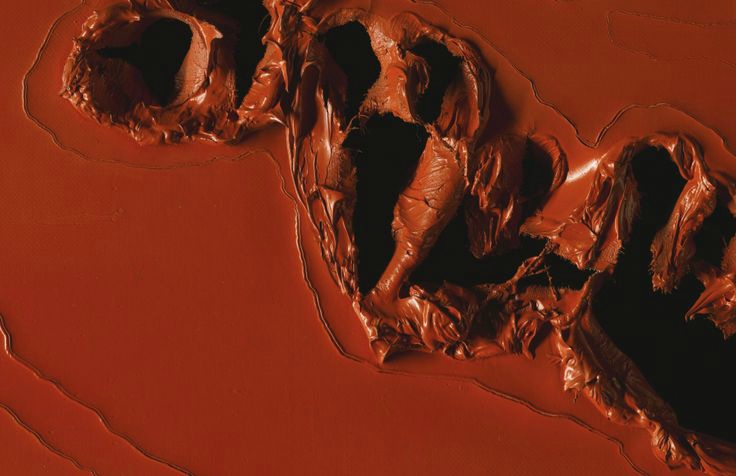Lucio Fontana (1899 - 1968), Concetto Spaziale
Lucio Fontana (1899 - 1968), Concetto Spaziale. Photo Sotheby's
signed; signed and titled on the reverse, oil on canvas, 92 by 74cm.; 36 1/4 by 29 1/8 in. Executed in 1963-64. Estimate 800,000 — 1,200,000 GBP
Provenance: Carlo Granata, Turin
Sale: Finarte, Milan, 24 June 1980, Lot 88
Private Collection, Italy
Sale: Christie’s, London, Post-War, 25 June 2001, Lot 63
Acquired directly from the above by the present owner
Exhibited: Milan, Palazzo Reale, Lucio Fontana, 1972, p. 266, no. 177, illustrated
Literature: Enrico Crispolti, Lucio Fontana, Catalogue Raisonné des Peintures et Environments Spatiaux, Vol. II, Brussels 1974, p. 480, no. 63-64 O 10, illustrated
Giulio Bolaffi, Ed., Catalogo Nazionale Bolaffi d’Arte Moderna, Vol. XVII, Turin 1981, p. 285, illustrated
Enrico Crispolti, Fontana: Catalogo Generale, Vol. II, Milan 1986, p. 480, no. 63-64 O 10, illustrated
Enrico Crispolti, Lucio Fontana, Catalogo Ragionato di Sculture, Dipinti, Ambientazioni, Vol. II, Milan 2006, p. 672, no. 63-64 O 10, illustrated
Note: Strikingly poised as though a crimson field punctuated with buttery perforations and cosmic constellations, Lucio Fontana’s Concetto Spaziale is a captivating example of the artist’s ongoing spatial investigations. As Enrico Crispolti categorises in his definitive Catalogue Raisonné on Fontana, these career-defining explorations into space can be demarcated by three central tenets: segno (sign), materia (material) and colore (colour). The Olii series, of which Concetto Spaziale is part, however, takes these three propositions in novel directions; the violent, visceral ruptures are a formal and conceptual development of the smooth openings found in Fontana’s earlier buchi and tagli.
Returning to Italy from Buenos Aires in 1947, Fontana advocated the principles of Spazialismo, a practice that sought to channel the concerns of mankind on the most universal scale to create an “art based on the unity of time and space” (Lucio Fontana, ‘Manifesto Blanco’ in: Enrico Crispolti, et al., Eds., Lucio Fontana, Milan 1998, p. 116). To understand Spazialismo, however, is to also understand the wider context of the space age; launched in 1957 when Sputnik orbited the earth it was in this same year that Fontana embarked upon his first Olii. The theme of space was a major preoccupation for the artist and the advent of the first man in space, Yuri Gagarin, in 1961 only escalated his interest in the Olii subject: “Einstein's discovery of the cosmos is the infinite dimension, without end. And here we have the foreground, middle ground and background, what do I have to do to go further? I make a hole, infinity passes through it, light passes through it, there is no need to paint. Everyone thought I wanted to destroy; but it is not true, I have constructed” (Lucio Fontana in conversation with Carla Lonzi in: Carla Lonzi, Ed., Autoritratto, Bari 1969, p. 176). With this extraordinarily simple gesture, Fontana opened up the two-dimensional space of the canvas to the third-dimension of the beyond.
For Fontana the Olii represented “the pain of man in space. The pain of the astronaut, squashed, compressed, with instruments sticking out of his skin, is different from ours… he who flies in space is a new type of man, with new sensations, not least painful ones” (Lucio Fontana quoted in: Exhibition Catalogue, Rome, Palazzo delle Esposizione, Lucio Fontana, 1998, p. 244). Replacing the twinkling, dreamy visions of the buchi and the philosophical calm of the tagli with the violent volcanic openings that explode and ooze across the fiery red surface of Concetto Spaziale, the artist’s pathos and existential angst towards space exploration, is all the more apparent. In an almost carnal act, Fontana has torn through the canvas, thrusting his hands through the densely impastoed layer of paint to create sensual eruptions of bubbling viscosity, that cling to the hewn flaps of canvas in the centre. Surrounding these visceral holes, Fontana has used a hard instrument in the wet paint to create wavy circular scratches and multiple perforations that exude eroticism, as though a celebration of sexuality. Here the sheer energy of Fontana's process harnesses an enigmatic combination of violence and delicacy. The sheen of the oil paint lends the piece a vitality enhanced by the crimson pigment, and immediately the piece commands a thrilling juxtaposition of delicate colouring and violation as inflicted by the artist. The physicality of Fontana’s conceptual process in Concetto Spaziale, realised with an unerring tactility, ultimately amounts to a profoundly moving visual experience.
Sotheby's. Contemporary Art Evening Auction. London | 30 Jun 2014 -http://www.sothebys.com/

/https%3A%2F%2Fprofilepics.canalblog.com%2Fprofilepics%2F1%2F0%2F100183.jpg)
/https%3A%2F%2Fstorage.canalblog.com%2F03%2F02%2F119589%2F96711876_o.jpg)
/https%3A%2F%2Fstorage.canalblog.com%2F11%2F31%2F119589%2F94773502_o.jpg)
/https%3A%2F%2Fstorage.canalblog.com%2F20%2F83%2F119589%2F94772815_o.jpg)
/https%3A%2F%2Fstorage.canalblog.com%2F26%2F72%2F119589%2F75604929_o.jpg)
/https%3A%2F%2Fstorage.canalblog.com%2F59%2F60%2F119589%2F26458628_o.jpg)




/image%2F1371349%2F20240313%2Fob_3da818_431115881-1632814154155264-57534444325.jpg)
/image%2F1371349%2F20240312%2Fob_cc9c83_f2.jpg)
/image%2F1371349%2F20240311%2Fob_2edda2_fontana.jpg)
/http%3A%2F%2Fstorage.canalblog.com%2F86%2F67%2F119589%2F129815803_o.png)